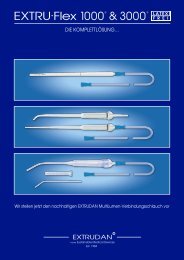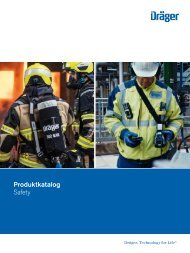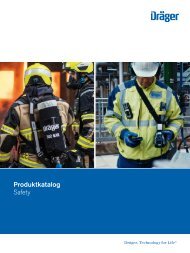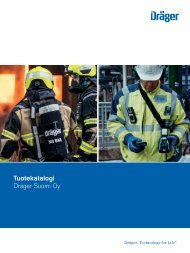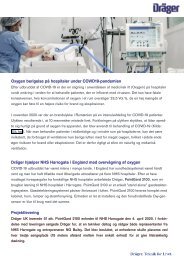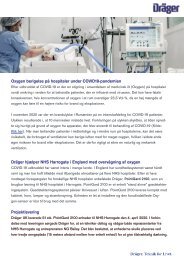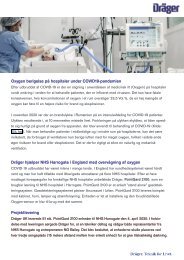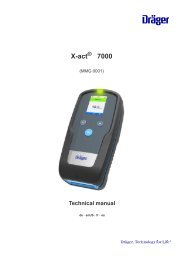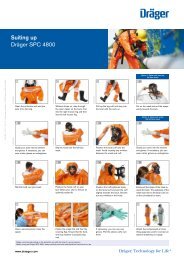Carcinogenic Substances at Work
You also want an ePaper? Increase the reach of your titles
YUMPU automatically turns print PDFs into web optimized ePapers that Google loves.
MEASURING CARCINOGENS<br />
CHALLENGES IN EVERYDAY WORK<br />
Precisely measuring carcinogenic substances<br />
in the field has always been difficult.<br />
Until recently, the sensor technology has been<br />
based on photo ionis<strong>at</strong>ion detectors (PIDs)<br />
or electrochemical sensors. However, these<br />
methods also detect hydrocarbons, such as<br />
styrene or butene. These types of associ<strong>at</strong>ed<br />
substances distort the assessment of the<br />
gas hazard. A selective and therefore exact<br />
measurement of for example a 1,3-butadiene<br />
concentr<strong>at</strong>ion was so far only possible with<br />
a specific short-term tube or by separ<strong>at</strong>ing<br />
1,3-butadiene from its associ<strong>at</strong>ed substances in<br />
a labor<strong>at</strong>ory via gas chrom<strong>at</strong>ography.<br />
The challenge therefore lies in devising a<br />
measurement technique th<strong>at</strong> can be performed<br />
in the field. It requires fe<strong>at</strong>ures such as:<br />
"usable in EX areas", "usable by gas analysts"<br />
and "simple functional check by the user".<br />
MEASUREMENT DIRECTLY ON SITE<br />
With on-site measurement technology, the<br />
measured value is directly available – a<br />
tank entry oper<strong>at</strong>ion, for instance, can thus<br />
be performed immedi<strong>at</strong>ely after testing. In<br />
addition, the gas analyst, who generally grants<br />
clearance for the work in areas polluted with<br />
explosive and toxic gases, can also verify the<br />
concentr<strong>at</strong>ion of carcinogenic substances.<br />
This also results in significant improvements<br />
in workplace monitoring. Using "on-site<br />
measurement technology", any given task<br />
can be monitored using random sample<br />
measurements as the measured value is<br />
directly available without delay. This results in a<br />
much higher level of safety and efficiency.<br />
LABORATORY TECHNOLOGY<br />
IN THE FIELD<br />
As a manufacturer of field-suitable gas<br />
measuring technology our goal is to make lab<br />
technologies suitable for the field, allowing<br />
safety officers react more quickly to peak<br />
exposure values. In many industries, vol<strong>at</strong>ile<br />
organic compounds – VOCs – are often<br />
a combin<strong>at</strong>ion of gas and vapour made up<br />
of various compounds. For example, the<br />
carcinogenic compound th<strong>at</strong> can cause longterm<br />
health damage in petrol is benzene. In<br />
the labor<strong>at</strong>ory, the selective measurement<br />
of benzene in petrol vapour is performed<br />
using gas chrom<strong>at</strong>ography, which first acts<br />
by separ<strong>at</strong>ing the vapour compounds into<br />
individual gases. Making this technology<br />
suitable for the field involves two important<br />
aspects in addition to mini<strong>at</strong>urising the testing<br />
device: firstly, it needs to be simpler to use,<br />
since it will be a gas analyst performing the<br />
pre-entry measurement, not labor<strong>at</strong>ory staff.<br />
This means th<strong>at</strong> a simple oper<strong>at</strong>ing concept<br />
for using and calibr<strong>at</strong>ing the device is required.<br />
Secondly, it generally needs to be suitable<br />
for use in EX zones. The devices must be<br />
industrially robust and have ATEX approval.<br />
These new types of solutions are available now<br />
after a decade of research.<br />
25 | 33




